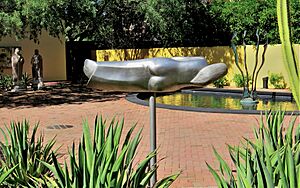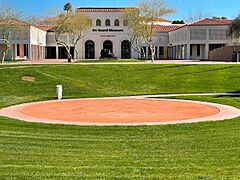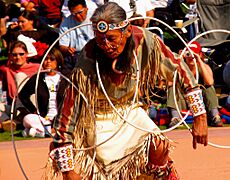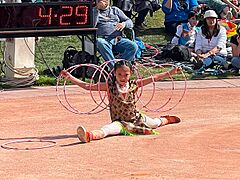Heard Museum facts for kids
 |
|
| Lua error in Module:Location_map at line 420: attempt to index field 'wikibase' (a nil value). | |
| Established | 1929 |
|---|---|
| Location | Phoenix, Arizona |
| Type | Private, not-for-profit museum |
| Accreditation | American Alliance of Museums |
| Key holdings | American Indian art |
| Collection size | 40,000 items |
| Visitors | 250,000 visitors a year |
| Founder | Dwight B. and Maie Bartlett Heard |
| Architect | Bennie Gonzales |
| Public transit access | 'Add→'Add→ Encanto/Central Avenue |
The Heard Museum is a special place in Phoenix, Arizona, United States. It is a private museum that focuses on American Indian art. The museum shares the stories of American Indian people from their own point of view. It also shows amazing art by American Indian artists. You can see both traditional and modern art here. The main museum in Phoenix is even called a "Phoenix Point of Pride"!
The Heard Museum used to have other locations. One was in Surprise, which closed in 2009. Another was in Scottsdale, Arizona, which closed in May 2014.
Contents
History of the Heard Museum
The Heard Museum started in 1929. It was founded by Dwight B. and Maie Bartlett Heard. They created the museum to share their own art collection with everyone. Many old artifacts in their collection came from a place called La Ciudad Indian ruin. The Heards bought this land in Phoenix in 1926.
Some parts of the museum were designed by a famous architect named Bennie Gonzales. He also designed the Scottsdale City Hall building.
Museum Collections and Exhibits
The Heard Museum has a huge collection today. It includes over 40,000 items. There is also a library with more than 34,000 books and documents. The museum has a lot of space for art, classes, and performances.
Some of the interesting exhibits you can see include:
- Home: Native Peoples in the Southwest: This exhibit shows how Native peoples live in the Southwest.
- The Mareen Allen Nichols Collection: This collection has 260 pieces of modern jewelry.
- The Barry Goldwater Collection: This collection features 437 historic Hopi kachina dolls. These are special carved figures.
There is also an exhibit about the boarding school experiences of Native Americans. In the 1800s, many Native American children were sent to these schools. This exhibit shows how their culture was affected. It uses old photos, uniforms, and interviews to tell their powerful stories.
The Heard Museum welcomes about 250,000 visitors every year. It is also connected to the Smithsonian Affiliations program. This means it works with the famous Smithsonian museums.
Museum Leadership
From 2010 to 2012, Dr. Letitia Chambers was the director. She was the first director of American Indian descent. From 2013 to 2015, James Pepper Henry led the museum. He is a member of the Kaw Nation and Muscogee Creek Nation. Since January 2016, David M. Roche has been the museum's director. The museum is also part of the North American Reciprocal Museums program.
Heard Museum Festivals and Events
The Heard Museum hosts many exciting events each year.
El Mercado de Las Artes
One event is the annual El Mercado de Las Artes. This usually happens in November. You can enjoy mariachi music while seeing art by Hispanic artists. These artists come from Arizona and New Mexico. They create beautiful santos, pottery, and colcha embroidery. You can also see furniture, paintings, and silver artwork.
World Championship Hoop Dance Contest
The Heard also hosts the annual World Championship Hoop Dance Contest. This contest usually takes place in early February. Hoop dancing is a special dance form. Dancers use hoops to create different shapes and tell stories. The contest is held outdoors in the Libby Amphitheater at the museum.
Annual Indian Fair and Market
The Annual Heard Museum Guild Indian Fair and Market is a very popular event. It has been held every March since 1958. This fair brings in about 15,000 visitors. Over 600 Native American artists show their work here. There is also a special competition called "Best of Show."
Artists compete in eight different categories. These include jewelry, pottery, paintings, and sculptures. They also compete in textiles, wooden carvings, and baskets. The judges for this competition are experts in art. Many of them are from American Indian tribes themselves. Awards and cash prizes are given for the best artwork.
See also
 In Spanish: Museo Heard para niños
In Spanish: Museo Heard para niños






